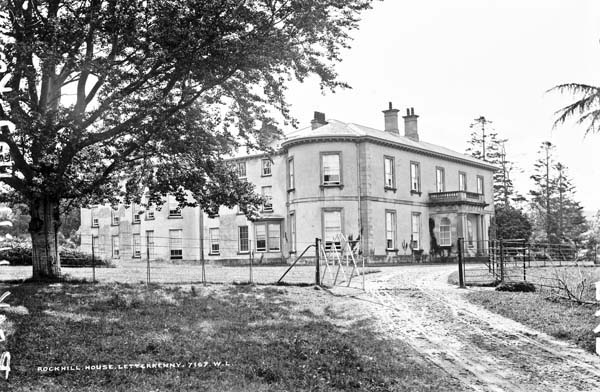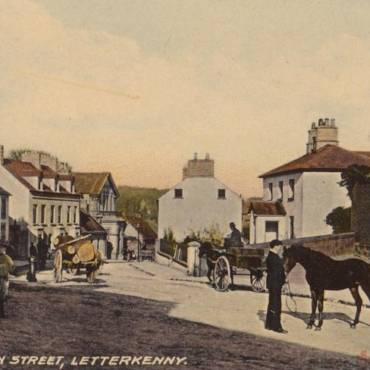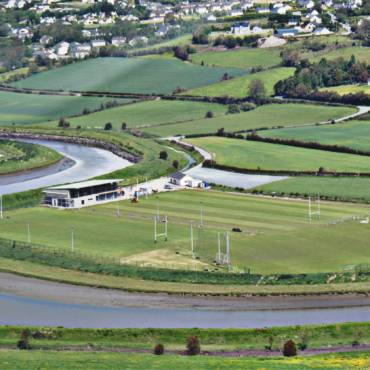Rockhill House
In the Plantation of Ulster, an English Knight Sir Thomas Coach was granted 1,500 acres on the south side of the River Swilly called ‘Lismongan’. While we might associate that solely with the small area of Lismonaghan today, the land in fact stretched out much further than that to take in the areas of Rockhill and Scarrifhollis also.
Coach’s son, Captain Thomas Coach, also held lands in Cabra, Co. Cavan and from the 1660s onwards, he confined his family business primarily to there. After bequeathing the estate to his son, Colonel Thomas Coach, the overall 1,500 acres then came into the possession of the Pratt family through marriage. Joseph Pratt was originally married to Frances Coach, sister to the Colonel but in 1686 was re-married to Elizabeth Coach, daughter to the Colonel. Upon Colonel Coach’s death in 1699, the lands of Lismonaghan passed to the Pratts who remained in the area right up until the nineteenth century.
Rockhill, or Corr as it was known then, being approximately 240 acres in size, was just a small part of this overall 1,500 acres of the Coach family estate. In a grant of 26 July 1693, John Chambers was granted the lands of Rockhill from Thomas Coach, grandson to the original patentee.
Thus the Chambers family came to occupy Rockhill at the end of the seventeenth century and they built a manor house on their lands, on the site of the current Rockhill House. These Chambers were descended from William Chambers who had been the Curate of Leck in 1633.
Daniel Chambers sold the estate at Rockhill to John Vandeleur Stewart of Ards on 21 February 1832 for £900 and retired to Loughveagh House on his other estate at Gartan (where Gartan Outdoor Pursuits centre now stands) but sold that in 1845 and moved to Dublin where he died in 1850.
John Vandeluer Stewart was appointed High Sheriff of Donegal in 1838 and made extensive renovations to the former Chambers house, so closely modeled on the Stewart family home of Ards House that they came to be almost ‘sister houses’. The Stewart estate stretched from Oldtown to Bomany and up to Letterleague where the ruins of the former gatehouse can still be seen. Flax, beet, corn and potatoes were cultivated on the estate with a large orchard near to the house while coursing and hunting on the estate was offered for £10 annually. The Rockhill Coursing Club was set up in 1890 with Sir Thomas Lecky as President. The Rockhill Stakes, The Letterkenny Stakes and The Swilly Stakes were competed for annually at Crieve Meadows, with competitors arriving with their greyhounds from all over the northwest.
John Vandeluer Stewart died in 1872 and the estate passed to his eldest son, Major General Alexander Charles Hector Stewart, who was High Sheriff of Donegal in 1881. Upon his death in 1917, the Rockhill estate was left in trust to his daughter Kathleen Stewart, but his brother Sir Charles John Stewart effectively became the administrator of the estate as she lived in Sussex with her husband Philip Arthur McGregor.
Sir Charles John Stewart and his wife, Lady Mary Stewart had two sons, John and Gerald, who were both killed within six weeks of one another in World War I. Upon their sons’ deaths in 1915, they were so heartbroken that they seemed to lose interest in returning to the estate of Rockhill. The land steward Robert R. Robinson tended to the management of the estate in Sir Charles John’s seasonal absences.
With nobody occupying the estate, Rockhill House was taken over by Anti Treaty IRA troops upon the outbreak of Civil War in Ireland in 1922. Across the river, Ballymacool House was also taken over with the Boyds being forcibly removed from their home. The Pro Treaty forces launched an attack on both houses on 22 June 1922 and removed the insurgents.
Owing to this political unrest in Ireland, the loss of his sons and an overall lack of interest from the family in the estate, Sir Charles John Stewart finally left Rockhill in 1927 and moved to Scotland. The family home then served as a Preparatory Irish College for student teachers until 1930 but the estate soon fell into decline and was sold in various lots on 19 January 1937 to the Commissioners of Public Works. The Department of Defence then came to occupy the main estate of 29 acres from the 1940s and housed the Army on a permanent basis from 1969 until 2009 when it closed due to government cutbacks on military expenditure. The house has recently been extensively refurbished and reopened as an elegant Country House and Estate.
For more on the history of Rockhill House, Lt. Col. Declan O’Carroll’s book, “Rockhill House: A History” is highly recommended.



